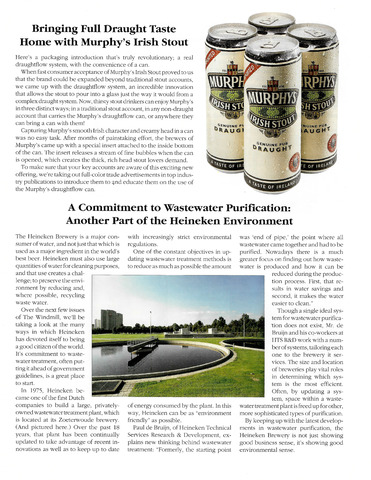Bringing Full Draught Taste
Home with Murphy's Irish Stout
A Commitment to Wastewater Purification:
Another Part of the Heineken Environment
Here's a packaging introduction that's truly revolutionary; a real
draughtflow system, with the convenience of a can.
When fast consumer acceptance of Murphy's Irish Stout proved to us
that the brand could be expanded beyond traditional stout accounts,
we came up with the draughtflow system, an incredible innovation
that allows the stout to pour into a glass just the way it would from a
complex draught system. Now, thirsty stout drinkers can enjoy Murphy's
in three distinct ways; in a traditional stout account, in any non-draught
account that carries the Murphy's draughtflow can, or anywhere they
can bring a can with them!
Capturing Murphy's smooth Irish character and creamy head in a can
was no easy task. After months of painstaking effort, the brewers of
Murphy's came up with a special insert attached to the inside bottom
of the can. The insert releases a stream of fine bubbles when the can
is opened, which creates the thick, rich head stout lovers demand.
To make sure that your key accounts are aware of this exciting new
offering, we're taking out full-color trade advertisements in top indus
try publications to introduce them to and educate them on the use of
the Murphy's draughtflow can.
The Heineken Brewery is a major con
sumer of water, and not just that which is
used as a major ingredient in the world's
best beer. Heineken must also use large
quantities of water for cleaning purposes,
and that use creates a chal
lenge; to preserve the envi
ronment by reducing and,
where possible, recycling
waste water.
Over the next few issues
of The Windmill, we'll be
taking a look at the many
ways in which Heineken
has devoted itself to being
a good citizen of the world.
It's commitment to waste
water treatment, often put
ting it ahead of government
guidelines, is a great place
to start.
In 1975, Heineken be
came one of the first Dutch
companies to build a large, privately-
owned wastewater treatment plant, which
is located at its Zoeterwoude brewery.
(And pictured here.) Over the past 18
years, that plant has been continually
updated to take advantage of recent in
novations as well as to keep up to date
with increasingly strict environmental
regulations.
One of the constant objectives in up
dating wastewater treatment methods is
to reduce as much as possible the amount
of energy consumed by the plant. In this
way, Heineken can be as "environment
friendly" as possible.
Paul de Bruijn, of Heineken Technical
Services Research Development, ex
plains new thinking behind wastewater
treatment: "Formerly, the starting point
was 'end of pipe,' the point where all
wastewater came together and had to be
purified. Nowadays there is a much
greater focus on finding out how waste
water is produced and how it can be
reduced during the produc
tion process. First, that re
sults in water savings and
second, it makes the water
easier to clean."
Though a single ideal sys
tem for wastewater purifica
tion does not exist, Mr. de
Bruijn and his co-workers at
HTS R&D work with a num
ber of systems, tailoring each
one to the brewery it ser
vices. The size and location
of breweries play vital roles
in determining which sys
tem is the most efficient.
Often, by updating a sys
tem, space within a waste
water treatment plant is freed up for other,
more sophisticated types of purification.
By keeping up with the latest develop
ments in wastewater purification, the
Heineken Brewery is not just showing
good business sense, it's showing good
environmental sense.
A^nuine
AU Gl
-UINE PuiV
Hssfr-
k^nuine

